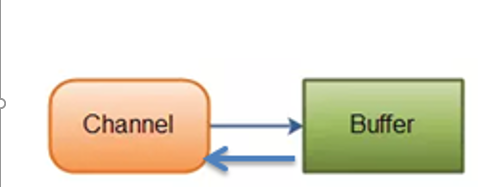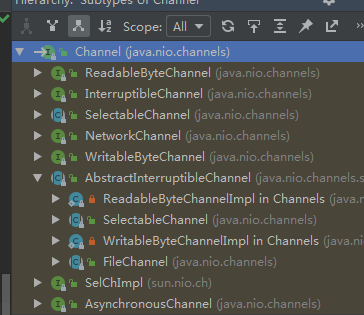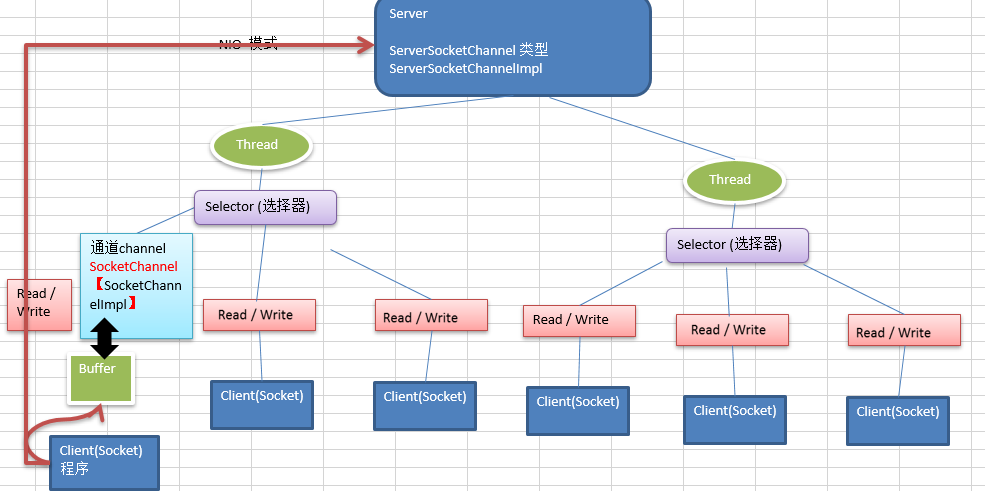netty的自我学习(三)—NIO的channel
学习这件事,不在乎有没有人督促你,最重要的是在于你自己有没有觉悟和恒心。
温习中,会以笔记的形式记录下自我学习的过程。预计1月底之前更新完毕,请关注。
文章部分图片来源于视频笔记!!非我自画!!

netty的自我学习(二)—初识NIO以及Buffer
NIO的channel基本介绍
- NIO的通道与流的区别:
-
BIO 中的 stream 是单向的,例如 FileInputStream 对象只能进行读取数据的操作,而 NIO 中的通道(Channel)是双向的,可以读操作,也可以写操作。
-
通道可以实现异步读写数据
-
通道可以从缓冲读数据,也可以写数据到缓冲

- Channel在NIO中是一个接口

- FileChannel 用于文件的数据读写
- DatagramChannel 用于 UDP 的数据读写
- ServerSocketChannel 和 SocketChannel 用于 TCP 的数据读写。

FileChannel-Demo
FileChannel主要用来对本地文件进行 IO 操作,常见的方法有

write-数据写入到本地文件

public static void main(String[] args) throws Exception{ String str = "hello,channel"; /** * 1 创建一个输出流->channel */ FileOutputStream fileOutputStream = new FileOutputStream("d://1.txt"); /** * 2 通过 fileOutputStream 获取 对应的 FileChannel * 这个 fileChannel 真实 类型是 FileChannelImpl */ FileChannel fileChannel = fileOutputStream.getChannel(); /** * 3 * 创建一个缓冲区 ByteBuffer */ ByteBuffer byteBuffer = ByteBuffer.allocate(1024); /** * 4 * 将 str 放入 byteBuffer */ byteBuffer.put(str.getBytes()); /** * 5 * 对byteBuffer 进行flip */ byteBuffer.flip(); /** * 6 * 通过write方法将byteBuffer 数据写入到 fileChannel */ fileChannel.write(byteBuffer); fileOutputStream.close(); } 复制代码 read-读取数据
public static void main(String[] args) throws Exception { //创建文件的输入流 File file = new File("d://1.txt"); FileInputStream fileInputStream = new FileInputStream(file); //通过fileInputStream 获取对应的FileChannel FileChannel fileChannel = fileInputStream.getChannel(); //创建缓冲区 ByteBuffer byteBuffer = ByteBuffer.allocate((int) file.length()); //将 通道的数据读入到Buffer fileChannel.read(byteBuffer); //将byteBuffer 的 字节数据 转成String System.out.println(new String(byteBuffer.array())); fileInputStream.close(); } 复制代码 文件读取,注意clear方法
public void copyFile() throws Exception{ /** * 需求 把文件1的数据 copy到文件2 */ FileInputStream fileInputStream = new FileInputStream("d://1.txt"); FileChannel channel001 = fileInputStream.getChannel(); FileOutputStream fileOutputStream = new FileOutputStream("d://2.txt"); FileChannel channel002 = fileOutputStream.getChannel(); ByteBuffer byteBuffer = ByteBuffer.allocate(1024); while(true){ /** * 取到buffer里 */ int read = channel001.read(byteBuffer); if(read == -1 ){ break; } byteBuffer.flip(); channel002.write(byteBuffer); /** * public final Buffer clear() { * position = 0; * limit = capacity; * mark = -1; * return this; * } * 为什么调用clear()? * 第一次读玩了 pos=limit * 那么下次循环在读的时候,read就一直是0,无限循环,因为读不到数据 * */ byteBuffer.clear(); //清空buffer } //关闭相关的流 fileInputStream.close(); fileOutputStream.close(); } 复制代码 文件拷贝
public static void main(String[] args) throws Exception { //创建相关流 FileInputStream fileInputStream = new FileInputStream("d://1.jpg"); FileOutputStream fileOutputStream = new FileOutputStream("d://2.jpg"); //获取各个流对应的filechannel FileChannel sourceCh = fileInputStream.getChannel(); FileChannel destCh = fileOutputStream.getChannel(); //使用transferForm完成拷贝 destCh.transferFrom(sourceCh,0,sourceCh.size()); //关闭相关通道和流 sourceCh.close(); destCh.close(); fileInputStream.close(); fileOutputStream.close(); } 复制代码 互相讨论、共同进步
文章笔记如有失误,请指出。
持之以恒!

正文到此结束
热门推荐
相关文章
Loading...











![[HBLOG]公众号](https://www.liuhaihua.cn/img/qrcode_gzh.jpg)

